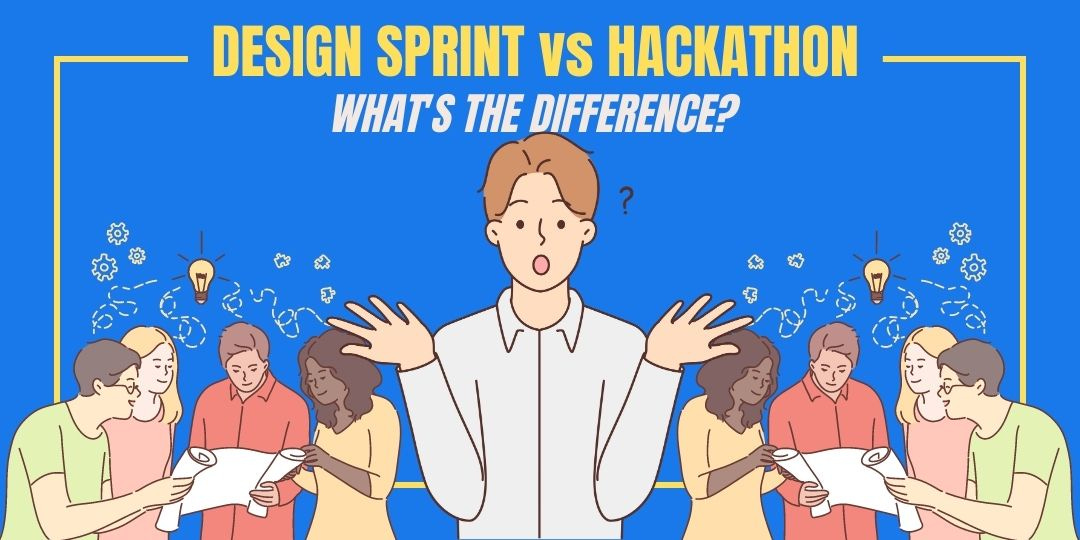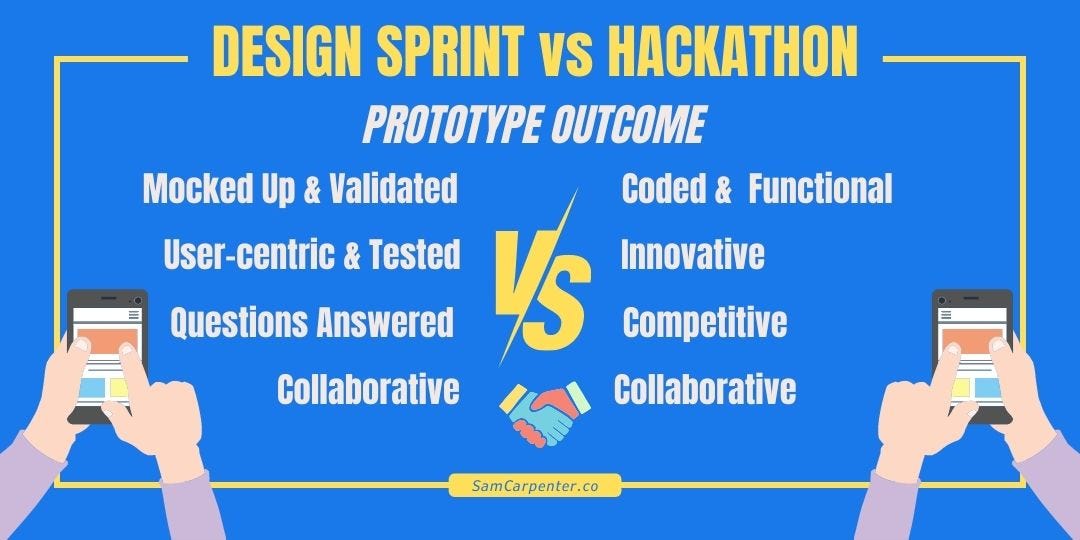Unless you’re under a rock, you’ve heard of, or even taken part in, a hackathon, right? On the other hand you may not be so familiar with design sprints, which seem to be in the lesser-spotted category. I’m passionate about design sprints and believe they should be more common place, because of all the equitable benefits they bring to help you, the products you’re working on and ultimately the company you work for.
In short
A design sprint and a hackathon are both collaborative events that bring together individuals with diverse skills and expertise to work on specific challenges. While both are collaborative events aimed at generating solutions, design sprints focus on a structured problem-solving process with a user-centered design approach, whereas hackathons generally emphasize coding and the development of functional prototypes.
While they share some similarities, there are distinct differences between the two:
The desired outcomes vary
Design Sprint: The main outcome of a design sprint is a tangible prototype or a set of prototypes that have been tested and validated with users and you now have a better idea if your prototype answers the question(s) you had about your new product or proposition. The prototypes serve as a basis for further iterations and development.
Hackathon: The primary outcome of a hackathon is a functional prototype, software application, or innovative solution that demonstrates the team's ability to solve a specific problem within the given time frame.
Purpose and Focus:
Design Sprint: A design sprint is a structured process aimed at solving complex problems and exploring potential solutions. It typically involves a small team working intensively over a short period, usually 5 days, to develop and prototype ideas. The focus is on user-centered design, validating assumptions, and creating a tangible prototype. No coding is needed.
Hackathon: A hackathon is an event where individuals or teams come together to collaboratively work on projects, often with a strong emphasis on coding and software engineering. The primary purpose is to build functional prototypes, innovative solutions, or software applications within a limited time frame, usually spanning a few hours to a couple of days.
Duration:
Design Sprint: A design sprint usually lasts for about 5 days. It follows a specific structure with designated activities for each day, including problem definition, ideation, prototyping, and testing.
Hackathon: Hackathons can vary in duration, but they typically range from a few hours to a couple of days. Some hackathons are even organized over a longer period, such as a week or a month.
Team Composition:
Design Sprint: Often involve a small, cross-functional team consisting of professionals from various disciplines, such as designers, developers, marketers, and subject matter experts. The team collaborates closely throughout the sprint to generate ideas, make decisions, and create prototypes.
Hackathon: Can be organised with teams of varying sizes, depending on the event. Often there is more than one team pitted against another and they are judged on the best solution presented at the end. Participants are encouraged to form teams with complementary skills, including developers, designers, and other relevant roles.
Approach:
Design Sprint: Follows a structured approach that incorporates various design thinking techniques to uncover insights, generate ideas, and rapidly prototype solutions. The process emphasises user research, ideation, rapid iteration, and user testing to validate assumptions.
Hackathon: Typically involves a more open-ended and flexible approach. Participants are often given a theme or problem statement, and they have the freedom to come up with their own creative solutions. The focus is on building functional prototypes or minimum viable products (MVPs) within the given time constraints.
Result:
Design Sprint: A product’s user journey and hard to find answers, on the product iteration, are defined and questions are answered from the collaborative prototype and the user testing of it.
Hackathon: A functional prototype, software application, or innovative solution has been developed, teams have competed with each other and shown their ability to solve a specific problem within the given time frame.
In summary, while both design sprints and hackathons are collaborative events aimed at generating solutions, design sprints focus on a structured problem-solving process with a user-centred design approach, whereas hackathons generally emphasise coding and the development of functional prototypes.
Discover more about design sprints in my 4-part blog, how-to guide.
If you want further support to either coach or train you in facilitating design sprints or hackathons, please contact me (see “4 links” in my profile).


